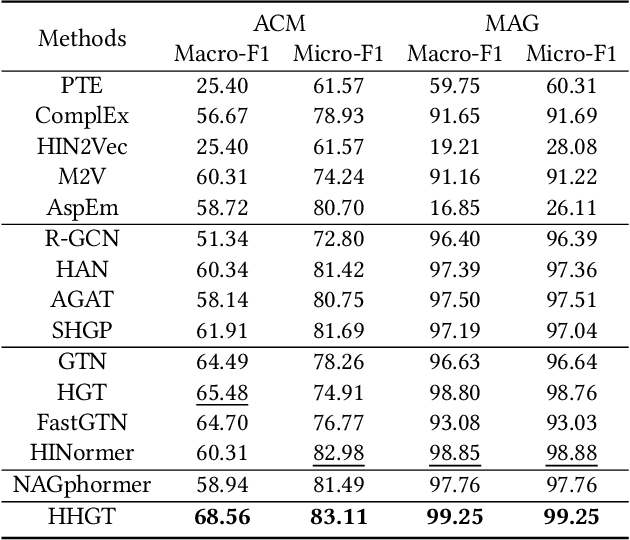Kaijun Liu
HHGT: Hierarchical Heterogeneous Graph Transformer for Heterogeneous Graph Representation Learning
Jul 18, 2024



Abstract:Despite the success of Heterogeneous Graph Neural Networks (HGNNs) in modeling real-world Heterogeneous Information Networks (HINs), challenges such as expressiveness limitations and over-smoothing have prompted researchers to explore Graph Transformers (GTs) for enhanced HIN representation learning. However, research on GT in HINs remains limited, with two key shortcomings in existing work: (1) A node's neighbors at different distances in HINs convey diverse semantics. Unfortunately, existing methods ignore such differences and uniformly treat neighbors within a given distance in a coarse manner, which results in semantic confusion. (2) Nodes in HINs have various types, each with unique semantics. Nevertheless, existing methods mix nodes of different types during neighbor aggregation, hindering the capture of proper correlations between nodes of diverse types. To bridge these gaps, we design an innovative structure named (k,t)-ring neighborhood, where nodes are initially organized by their distance, forming different non-overlapping k-ring neighborhoods for each distance. Within each k-ring structure, nodes are further categorized into different groups according to their types, thus emphasizing the heterogeneity of both distances and types in HINs naturally. Based on this structure, we propose a novel Hierarchical Heterogeneous Graph Transformer (HHGT) model, which seamlessly integrates a Type-level Transformer for aggregating nodes of different types within each k-ring neighborhood, followed by a Ring-level Transformer for aggregating different k-ring neighborhoods in a hierarchical manner. Extensive experiments are conducted on downstream tasks to verify HHGT's superiority over 14 baselines, with a notable improvement of up to 24.75% in NMI and 29.25% in ARI for node clustering task on the ACM dataset compared to the best baseline.
Non-orthogonal multiple access enhanced multi-user semantic communication
Mar 12, 2023



Abstract:Semantic communication serves as a novel paradigm and attracts the broad interest of researchers. One critical aspect of it is the multi-user semantic communication theory, which can further promote its application to the practical network environment. While most existing works focused on the design of end-to-end single-user semantic transmission, a novel non-orthogonal multiple access (NOMA)-based multi-user semantic communication system named NOMASC is proposed in this paper. The proposed system can support semantic tranmission of multiple users with diverse modalities of source information. To avoid high demand for hardware, an asymmetric quantizer is employed at the end of the semantic encoder for discretizing the continuous full-resolution semantic feature. In addition, a neural network model is proposed for mapping the discrete feature into self-learned symbols and accomplishing intelligent multi-user detection (MUD) at the receiver. Simulation results demonstrate that the proposed system holds good performance in non-orthogonal transmission of multiple user signals and outperforms the other methods, especially at low-to-medium SNRs. Moreover, it has high robustness under various simulation settings and mismatched test scenarios.
 Add to Chrome
Add to Chrome Add to Firefox
Add to Firefox Add to Edge
Add to Edge